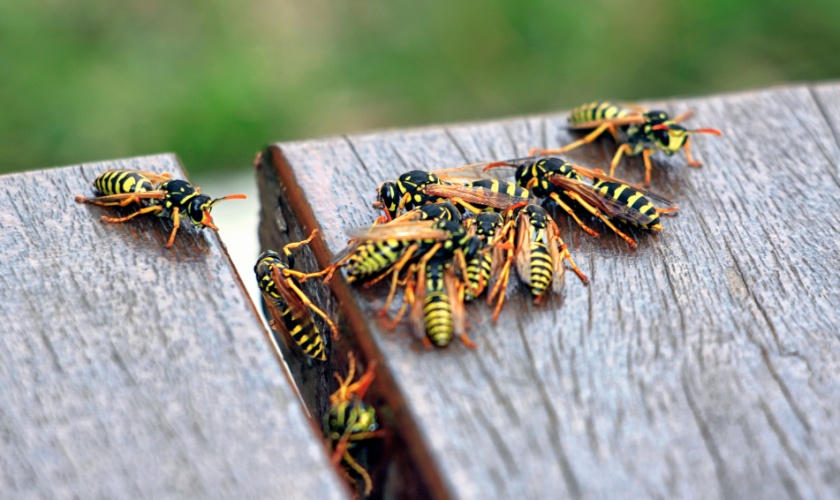If you’ve noticed an increase in yellow jacket activity around your Morgan Hill property this year, you’re not alone. Many local residents have reported higher-than-normal yellow jacket populations, raising concerns about outdoor activities and potential stinging incidents. Several factors contribute to these periodic population booms in our region.
Weather Patterns and Yellow Jacket Populations
Weather conditions play a significant role in determining yellow jacket numbers from year to year:
Mild Winters
When Morgan Hill experiences milder winter temperatures, more yellow jacket queens survive their hibernation period. Each surviving queen has the potential to establish a new colony in spring, leading to an exponential increase in the overall population.
Early Spring Warming
When early spring temperatures warm steadily without late frosts, newly emerged queens can establish nests earlier, giving colonies more time to grow and develop before peak season. This extended development period allows colonies to reach larger sizes than during years with erratic spring temperatures.
Precipitation Patterns
Proper soil moisture levels make digging easier for ground-nesting yellow jacket species, while moderate rainfall increases plant growth and insect populations that serve as food sources. Years with optimal precipitation patterns—neither drought nor excessive rainfall—tend to support larger yellow jacket populations.
Ecological Factors
Natural ecological cycles also influence yellow jacket numbers:
Predator Population Fluctuations
Natural predators of yellow jackets include certain birds, skunks, raccoons, and parasitic insects. When these predator populations naturally decrease, yellow jacket survival rates increase accordingly.
Prey Availability
Years with abundant caterpillars, flies, and other insects that yellow jackets prey upon support larger colony development. Morgan Hill’s agricultural surroundings and diverse ecosystem can create ideal conditions for these prey species, subsequently supporting more yellow jackets.
Reduced Competition
When competing wasp species experience population declines due to disease, habitat disruption, or other factors, yellow jackets face less competition for resources and nesting sites, allowing their populations to expand into newly available ecological niches.
Human Activity Influences
Our own behaviors and land management practices affect yellow jacket populations:
Landscaping Changes
Recent landscaping trends in Morgan Hill neighborhoods—including increased native plantings, mulched beds, and water-conserving designs—may inadvertently create more favorable yellow jacket habitat. Native plants attract native insects, which become food sources for yellow jackets.
Construction and Development
Ongoing development in previously undisturbed areas of Morgan Hill disrupts existing yellow jacket territories, potentially pushing colonies into residential spaces where they hadn’t previously established. Construction activity can also expose underground nest sites, forcing relocations.
Waste Management Practices
Changes in community waste management, such as reduced collection frequency or different container types, can influence yellow jacket foraging patterns, especially in late summer when workers are attracted to sugary food waste.
Colony Life Cycle Timing
Yellow jacket colony development follows a predictable annual cycle, but population peaks may seem more intense because:
Early Season Start
When colonies establish earlier in the season due to favorable conditions, they reach their maximum size sooner and remain at peak populations for longer periods.
Late Season Perception
Most people notice yellow jacket activity more in late summer and early fall when colonies reach maximum size and workers shift from hunting insects to seeking sugary foods—precisely when humans are most likely to be enjoying outdoor activities.
Managing Higher Yellow Jacket Populations
When facing years with higher-than-normal yellow jacket activity:
- Enhance preventative measures around food and waste
- Conduct regular property inspections to identify nests early
- Consider professional perimeter treatments to discourage foraging in outdoor living spaces
- Use yellow jacket traps strategically placed away from high-traffic areas
At Citra Pest Control, we understand the specific conditions affecting yellow jacket populations in Morgan Hill. Our targeted approach addresses both active nests and preventative measures to help you reclaim your outdoor spaces during these high-activity periods. Our technicians are trained to identify the specific yellow jacket species present on your property and apply the most effective control strategies.
Don’t let a bumper crop of yellow jackets ruin your outdoor enjoyment—contact us for a customized management plan tailored to this year’s unique conditions.

